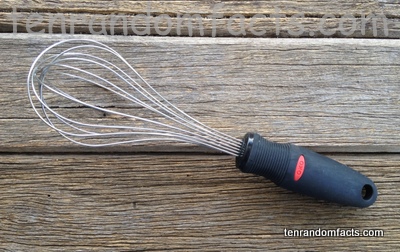A whisk, a handle and wire, is an effective, simple invention.
- Whisks are utensils used primarily to beat, blend or whip food liquids during preparation or the cooking process.
- A whisk typically has a looped wire top and a long and slim handle.
- Historically, twigs or small branches of trees have been used to beat, whip or blend food items like a whisk, and often fruit tree twigs were used to add flavour to the mixture.
- Whisk handles and/or wires can be made of plastic, metal, wood or bamboo.
- The wire tops of whisks are usually either round shaped, or flat, although they can vary in shape and size, depending on their recommended use, and include ‘flat’, ‘gravy’, ‘French’, ‘coil’, and ‘ball’, as well as the most popular shape, ‘balloon’, which has a rounded top.
- The more wires a whisk has, the more air can be whipped into the liquid more quickly, and round shaped tops are better for this purpose, while flat ones are more suited for mixing and smoothing thick liquids.
- It is believed that wire whisks were first invented during the 1800s, and a number of patents were issued in that era for whisks that look similar to those used today.
- French whisks are an all purpose long balloon shaped utensil, and coil, or ‘twirl’ whisks as they are also known, have a spring like top designed to be twirled or pushed up and down in the one spot, and are good for frothing milk.
- Whisks became popular from 1963, due to the American chef, Julia Child, who used the item to ‘magically’ create meringue on a television show.
- ‘Whisk’ most likely comes from the Scandinavian word ‘visk’, that means ‘rapid sweeping movement’ or ‘quick stroke’, and the word first referred to a tool or utensil in the 1660s.
Bibliography:
Kennedy J, Who Made That Whisk?, 2012, The New York Times, http://www.nytimes.com/2012/10/14/magazine/who-made-that-whisk.html?_r=0
Whisk, 2014, Wikipedia, http://en.wikipedia.org/wiki/Whisk
Whisks – History, Types, Video, 2012, The Reluctant Gourmet, http://www.reluctantgourmet.com/whisks-history-types-video






